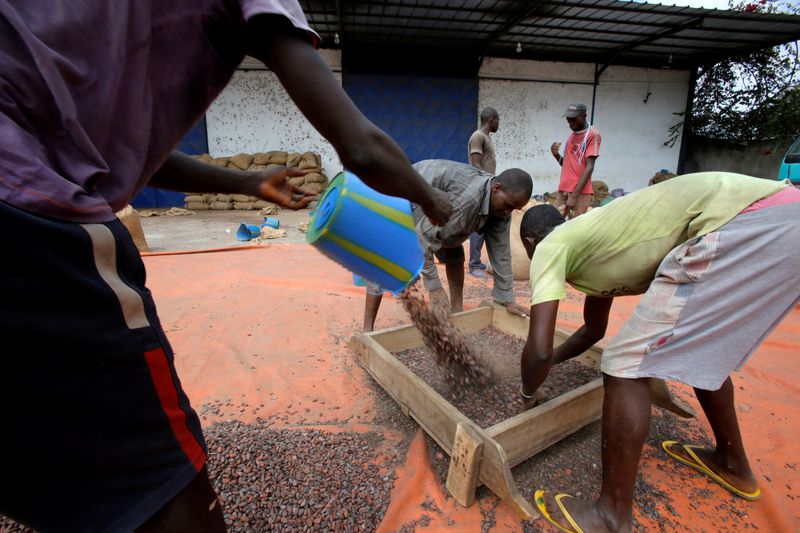By Ange Aboa and Aaron Ross
ABIDJAN (Reuters) - The use of child labor on cocoa farms in top producers Ivory Coast and Ghana has risen over the past decade despite industry promises to reduce it, according to a draft of a U.S. government-sponsored report seen by Reuters.
More than 2 million children worked in the sector last season in the West African countries that produce about two-thirds of the world's cocoa, according to the draft of a report funded by the U.S. Department of Labor. It is expected to be published later this month.
The level of child labor is higher than in 2010 when companies including Mars, Hershey, Nestle and Cargill pledged to reduce the worst forms of child labor in their West African supply chains by 70% by 2020.
In terms of the proportion of children from families working in the cocoa sector that are engaged in child labor, that increased to 46% in the 2018/19 season from 44% when the last survey was conducted in 2013/14, the U.S. report showed. The proportion engaged in hazardous labor, such as using sharp tools, stayed steady at 42%.
Those figures are more than 10% higher than when the first survey was conducted during the 2008/09 season and reveal the difficulty of eradicating child labor from a growing and sprawling sector that provides much-needed livelihoods for thousands of poor communities.
It may also add to pressure on cocoa traders and chocolate companies, who have faced criticism from U.S. lawmakers for failing to root out child labor from their supply chains. [nL8N2BC4SG]
"This report makes a strong case for understanding child labor and hazardous child labor in cocoa production as a complex problem requiring multiple complementary solutions," said the report.
Elizabeth Akanbombire, the head of the child labor unit at Ghana's employment ministry, said she could not comment on the report since it was not yet public.
The Ivorian government committee responsible for child labor issues said the numbers in the draft shouldn't be considered final because there were some issues with the methodology that have yet to be resolved to the government's satisfaction.
Richard Scobey, the head of the World Cocoa Foundation (WCF), an industry group that represents companies including Nestle and Hershey, acknowledged that the industry was not on track to meet its target set in 2010. But he said the report was not complete and he could not yet comment.
"Government and company programs to reduce child labor have shown significant success," he said, pointing to one initiative - the International Cocoa Initiative - that is backed by the chocolate and cocoa industries and civil society and says it has reduced child labor by half where it operates.
"The challenge now is to scale up these interventions," Scobey said.
Nestle referred Reuters to the WCF. Mars and Hershey both said it was too early to discuss the report. Cargill did not immediately respond to requests for comment.
The report, conducted by researchers at the University of Chicago, is the third in a series of surveys of cocoa farmers called for by an agreement between the industry and U.S. lawmakers first struck in 2001. It was based on a survey of more than 2,000 households.
It estimated that approximately 2.1 million children in the two countries' cocoa sectors are engaged in child labor, which includes work by under-12s and by older children that is hazardous or exceeds a certain number of hours.
That is similar to the estimate from the 2013/14 survey, but the report said those two numbers could not be compared because of methodological differences.
It said rises in the proportion of children working in the sector could be due to increased cocoa prices and production, which have pushed farmers to grow cocoa.
Cocoa output in Ivory Coast and Ghana rose to about 3 million tonnes last season from around 2.65 million tonnes in 2013/14.
